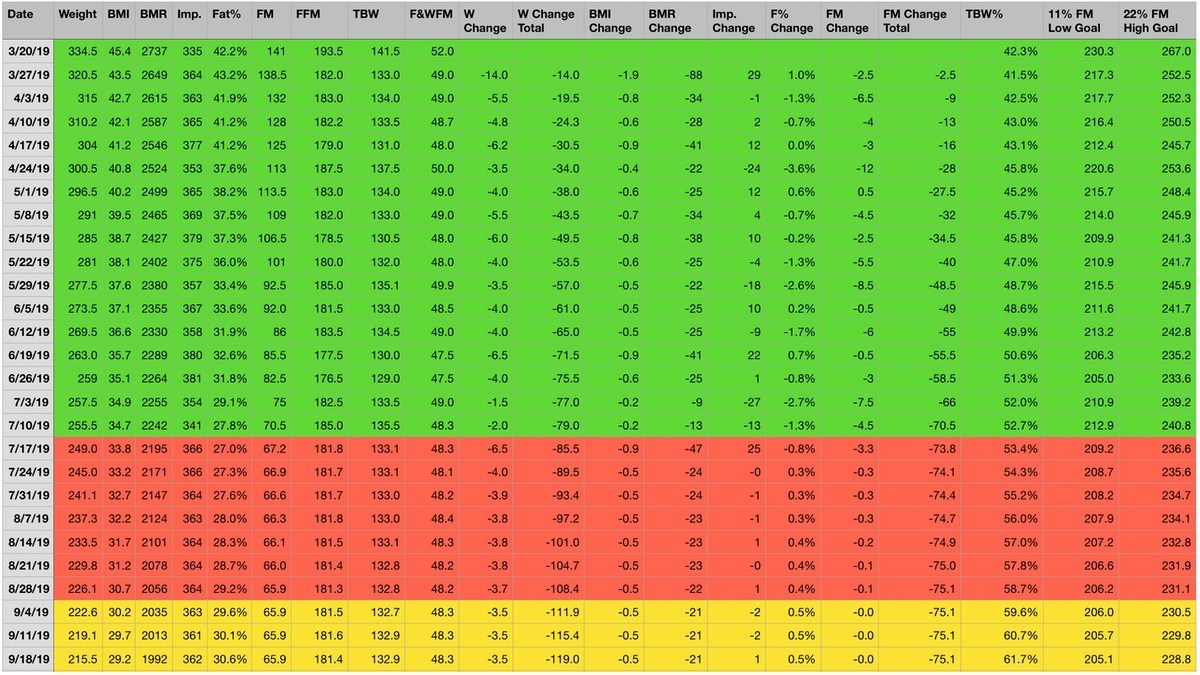 Weight Loss Is About More Than Losing Weight
Weight Loss Is About More Than Losing Weight
Yeah, weight, no duh. However, it shouldn’t be the only thing.
We have one of those digital scales at home that also uses the bio-impedance method to figure out what percent body fat we’re at by passing a low-level charge through our bodies, doing some math, and looking up results on some standardized tables that are pre-programmed into the device. While these will get a person into the ballpark, they are notoriously not super-accurate, and are better for tracking trends than they are for precision readings.
The scale we’ve been using for weigh-ins as part of the medically-supervised program we’re on is a bit more on the medical-pro level, though, and the data we’ve gotten from it, and tracked over time, is both more accurate and has done more to inform and educate me about factors beyond weight than anything else has ever done.
As you may know from some of my previous posts (like the one about finding a new car), I’m a spreadsheet guy. If I need to make a decision about something, and there’s data involved, I will resort to a spreadsheet to track and evaluate that data. This diet has been no different.
And the cool thing about the weekly weigh-in scale is that it spits out these little receipts with a bunch of data on them that I’ve gone to spreadsheet town over. The big ones are weight (of course), fat%, fat mass, fat free mass, and total body water. It also calculates the BMI – the Body Mass Index, which we’ve all likely heard, and perhaps worried, about for all our lives. One of the most important things I’ve learned over this diet and the associated data tracking is this: the BMI is a load of crap.
The BMI Is a Load of Crap
The body mass index is actually a pretty simple calculation, but may seem like a bit of a mystery to a lot of people, who just get told to “keep your BMI under 25 to be considered healthy.” To get your BMI, you divide your mass (in kilograms—yes, it’s actually a sneaky metric thing!—by the square of your height (in meters); you can also do it in imperial, by dividing your mass in pounds by the square of your in feet, and multiplying that whole outcome by 703 to adjust.
The thing is, the number itself doesn’t mean anything. They used it in comparison to some very generalized tables of values for a set of people (mostly white Europeans), and came up with approximate ranges where people who are healthy, overweight, or obese should fall. However, it’s so generalized that it can do more harm than good. Indeed, the people who coined the term and developed the system “explicitly judged BMI as appropriate for population studies and inappropriate for individual evaluation.” It’s not supposed to be used for any single person to determine their health; while it’s fine for very large groups, on the individual level, it breaks down.
For example, my case: I’m 6′ tall. According to the chart, to be just under the overweight category, I should be under 180 lbs. However, aside from my weight issues, I am a solidly-built person. I’ve never been a weight lifter, but I walk a lot, and have always been reasonably active. As I’ve collected all the data from the pro-grade scale over time, I’ve been tracking my FFM—fat free mass. That’s just all of me that’s not fat, meaning water, bones, muscle, and other bits. As I’ve normalized my water intake, and maintained my muscle mass, the data has shown my FFM has stayed in a pretty constant range: about 180-183 lbs.
So, that means, if I want to be considered healthy according to the BMI, I’d have to have 0% body fat. Um, no.
This has totally drilled into me (and will hopefully help you understand) that what’s really important isn’t the BMI, but a healthy body fat % and muscle mass. According to science, for my age and biological gender, the healthy range of body fat for me should be between 11% and 22%. Now that I know my average FFM, it’s easy enough to calculate my healthy weight range (which is about 205 lbs. to 230 lbs.). Indeed, my current goal is to hit the midpoint of that range (about 218 lbs.) and see how I look and feel. While the BMI would say I’m still overweight, that’s not a voice I’m listening to anymore.
Your Weight Isn’t Your Weight
Here’s another crazy thing that we don’t always think about: what we weigh when we weigh ourselves isn’t really what we weigh that day. Yes, it’s what we weighed at that exact moment (within a margin of error unique to that scale), but the moment you start actually living your day each morning, your weight will fluctuate. You go to the bathroom, you weigh a little less. You drink a mug of coffee, you weigh a bit more. You go through the day putting stuff into your body and letting it back out, and you do various types of work in various conditions that cause you to use some of the stuff in you to fuel that work, and you give off heat and you breath out moisture. All of it changes your weight every single second.
Which is why having a digital scale that tells you your weight to a tenth of a pound (or kg.) can be so… frustrating!
If I weigh myself in the morning, and my scale has a margin of error of +/- 0.1%, that’s still a possible 1 pound of variance, just to start. Just to be healthy in terms of hydration means I’m drinking at least a gallon of water each day. That means each day I’m putting over 8 pounds of water into my body, and assuming that through sweat, breathing, and trips to the bathroom, I will have hopefully gotten rid of however much should be considered above my normal retained amount, right before when I weigh myself. Plus, whatever food I ate in the previous day since I last weighed myself has been appropriately processed and disposed of, so none of its mass is jiggering the results.
But the problem is that, as much as we think we know, our bodies are still black boxes that don’t act predictably at the day-to-day level we wish they did. And when it comes to losing weight, that’s always apparent. Indeed, the cycles going on inside our bodies that affect our weight aren’t running on 24-hour or weekly clocks, and so even if we weigh ourselves at the same time each day or each week, that weight cannot always be compared to the previous weight at the same time or day, because the conditions under which the data is being collected aren’t the same.
All this is a long-winded way to say that tracking the piece of data that we think is most important when we’re on a diet, our weight, isn’t going to be much fun, because only over longer stretches of time can we reliably look at the trends. Each specific data point means very little, and putting too much emotional, uh, weight on them should be avoided if possible.
This is also to explain why I’m not trying to lose weight to get to one perfect number. I’m trying to get myself in the middle of what’s considered a healthy range (that 11% – 22% body fat), and then I’m going to do my best to float there, letting the cycles of my body nudge me up and down. I’m not going to freak out if the scale tells me I’m up a pound or two on any given day; I’m going to track my status over time, and just react to the trends as they happen.
Conclusion
For a data geek like me, this process has had its ups and downs (ha!). Due to variations in how much water my body decides to hold onto as of one certain moment each week, while I may have lost 4 pounds of fat since the last weigh-in (+/- scale error), the scale may say I only lost 0.5 pounds, and it bums me out. That’s why I’ve worked hard to (but only somewhat succeeded at) ignore the immediate results and watch the trends. As of my last “official” weigh-in, I’ve lost 71 pound of body fat, and 8 pounds of retained water, for a total of 79 pounds of total weight lost. That’s a trend that I’m very, very proud of.
On top of that, we’re getting into the nitty-gritty of tracking calories and macronutrients so we can plan our meals in a way that this weight loss will be sustainable, which I’ll talk more about in an upcoming chronicle. But what’s cool about tracking those number is that—you guessed it—I can do it on a spreadsheet. MOAR DATA!




Excellent article Ken – thanks for sharing! I especially liked the info about the BMI and FFM – especially for me because, like you, I’m naturally a bigger built guy and the BMI says I’m obese. I really like how you used the BMI + a “normal” amount of body fat to come up with your own personal healthy weight range. I’ll be doing the same thing!
Cheers!
And thank you, Barry! Yeah, FFM + some # of body fat just makes so much more sense. The BMI is an insidious monster that should be done away with! 😉